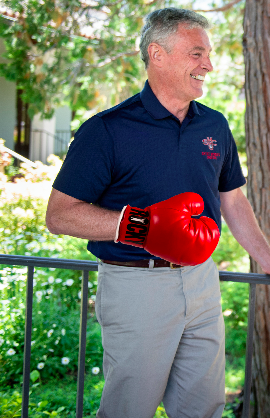 Can Plumb hold his title, or will there be a new king in town? By Vinny Paz The upcoming Inauguration of President Plumb as 30th president of the college is a historic occasion. Why should students be interested in attending? Besides the complimentary snacks, there will be a spectacle to behold before the reception. As per Saint Mary’s tradition, the role of President can be challenged via trial by combat before the elected president is sworn in. Rules of the bout: The chapel lawn will serve as the venue for the bout. Duels will be started with the ringing of the Chapels bell. The fight is a no holds barred ordeal. The duel ends when a brother throws in a towel, or a contestant yells “Gael!” Students may see President Plumb around campus this week preparing to defend his title. There have already been some verified student sightings of his training exercises. A pub employee claims that Plumb comes in at 5am every day, ordering a pint of raw eggs. The pub is considering putting this on tap. He’s been spotted running up to the tree of life with Brother Camillus on his back. Several seminar students have seen Plumb hop into their windows on the third floor, say, “G’day,” and let himself out through the door. Rumor has it that Plumb has also been sparring with Floyd Mayweather to sharpen his jab. Word of the opportunity to seize the throne has spread far and wide. Gonzaga’s head basketball coach Mark wanted to give the position a shot, but is stuck in Spokane after he blew a BAC too high to start his car. Amateur fighters from around the world have flown in to Moraga for the opportunity to compete for the title. Some boxing legends including Rocky Balboa and Clubber Lang have voiced their interest as well. Will Plumb’s egg smoothies and eccentric training pay off? What might happen to the curriculum if former heavyweight champion Mike Tyson steals the title?
0 Comments
Aristotle would be proud!
By Riley Mulcahy Cold Case Detective In a shocking turn of events, it has been revealed that a Saint Mary’s College professor in the Philosophy department indeed is the Zodiac Killer. “We didn’t see any red flags, the professor seemed to be level-headed, but he sometimes strayed from our Lasallian values. I mean can anyone be certain that your roommate is not a killer?” an unnamed source from the SMC administration asks. Given the fact all of this is so new, no one would go on the record, but there are people taking bets on who the professor is. “I heard that it is a raccoon disguised as a professor,” one student said outside of Cafe Louis. If the professor is a raccoon, that would have severe ramifications for the students. For one, where do raccoons go to prison? How can anyone know what those think and why one would kill anyone? The Philosophy department, which is small but mighty, would not stoop so low as to hire raccoons as professors. Or would they? At the time of the writing of this article, no arrests have been made in the case, leading to more suspicion that it indeed was a raccoon. The professor is out on bail until they can question him and look more into the raccoon theory. The Zodiac Killer was believed to be dead for years. However, we have been living with a killer amongst us for so long, and we never even realized his trick of cryptograms and ciphers until one day, another unnamed student saw someone walking suspiciously to class, and when the cops came, they saw the killer in the bushes near Becket Hall. For the SMC community: if we don’t stay prepared, there can be a killer in our sights at any time. Read philosophical texts with a vengeance! (Image Courtesy Vox) By Kamryn Sobel
Associate Editor “Theres a lot of discrimination happening on campus towards upper middle class students. We are basically a minority,” said senior business analytics major Kayleigh McLeighleigh. “I don’t know how many times I have to tell people, I’m not rich, my family is comfortable.” Recently on the Saint Mary’s campus, there have been reports from the wealthy student population facing discrimination due to the issue of having familial wealth. One student anonymously commented on the issue as, “Disheartening. I never would have imagined my peers to treat me so differently because of how much money my family has,” they said. “It’s not my fault my parents gave me these materialistic things and sent me to a private school. How can I be shamed for something that gets handed to me?” In response to these complaints from students at Saint Mary’s, the Outercultural Center has offered a new identity affinity group for these marginalized students. The goals of the Outercultural Center is to ensure that all students on campus have a safe environment and to support and advocate for underrepresented groups at Saint Mary’s. Specifically, in an email sent to students on behalf of the OC, it states, “Here at the Outercultural Center, we strive to create an environment in which students of all identities feel empowered and connected to the Saint Mary’s community. Within the last several weeks, however, students who come from a background of wealth have been targeted and have faced prejudice. In order for everyone to feel they have a voice, be heard, and most importantly, feel supported; the Outercultural Center has developed the Wealthy Student Identity Group. Everyone who feels as if they have been misrepresented or have been victim to the recent reports, please stop by the Outercultural Center this Friday, April 1st 2022, located at the Bassin Student Union here on campus!” One specific report came from Regina Seorge, a junior here at Saint Mary’s. “I walked into Bolivar Hall on Monday, March 21st in my Artitzia sweatsuit with a matching Louis Vuitton for lunch with my three best friends. As soon as I sat down, one of my so-called best friends said to me, ‘You can’t sit with us,’ while pointing at what I was wearing.” Seorge also reported that they declined her offer of a ride home in her brand new Mercedes SUV, “We will walk home,” they said. Laughter was then described by Seorge from the rest of the students at Bolivar Hall. President Rick Prune shared with students via Instagram story that the college is making great efforts to ensure that all students, staff and faculty feel they have a place here at Saint Mary’s. President Prune was also seen stepping out of his new limousine and headed to discuss a possible new building on campus dedicated to wealthy students, in order to help show his support to those who have fallen victim in the recent reports. Both the new building and limousine were heard to be donated by the students’ families. In an interview with President Prune following the announcement of a possible new building at Saint Mary’s, he said, “Although I cannot confirm at this time if this will take place, the college feels as if a new building on campus for students who are facing discrimination can bring high spirits and encourages everyone in the Saint Mary’s community to feel connected and included.” Freshman John Doe leaves Saint Mary’s with this piece of advice to help move forward as one and to continue making progress against discrimination, “Don’t believe everything you see or hear. Everything is not as it seems.” (Image Courtesy GettyImages) All Previous SMC Graduations Have Been Rendered Invalid Due To One Small Mistake
By Benjamin Noodle News Reporter All Saint Mary’s College graduations, from 2004 to 2021, have been invalidated due to a single mistake during the Commencement ceremonies. Students have been starting the ceremony with their tassels on the left, moving them to the right during the ceremony. According to the Statues on Graduations of 1937, students must move tassels from the right to left in order for their graduation to be valid. Over 10,000 students are left with crippling student debt, and only a high school diploma to show. Companies have caught wind of this news, resulting in Saint Mary’s alumni being let go from their jobs quicker than the A’s outfield drops their catches. Saint Mary’s President Richard Prune commented on this, stating, “ask not what Saint Mary’s can do for you,” before promptly knocking over the complimentary orange juice and exiting the Collegian interview room. Despite the disaster at hand, an anonymous SMC graduate (Class of 2009), has come out on top of this fiasco. After deliberating with his legal team, this former student exploited a loophole involving the starting position of the tassel. After a back-and-forth three-set match in the Wimbledon Court, the team beat the Saint Mary’s brothers’ defense decisively in the last volley of arguments. He is now being awarded a Masters degree of his choosing, summa cume laude. While he has yet to declare the Master’s degree he plans to accept, the Brothers and Sisters of the Saint Mary’s board are prepared for anything. The school is at his mercy and must offer him the degree of his choosing, or face dire consequences. Word on the street is that he will opt for a Masters of Aeronautics, Sailing, and Submarining. Contingent of being awarded his MS of A.S.S., he has been preemptively offered roles in NASA, the Armenian Navy, and the Death Valley Sailing Association. Will more miffed students follow in his footsteps? Will Aerospace Engineering ever be the same? Will all these Masters degrees flood the market? Stay tuned for more updates. (Image Courtesy GettyImages)  By Theo Zittel News Reporter “It's actually very simple to understand,” said freshman Carston Smith. “I should know, I’m a politics major.” The first-year student, Carston Smith, is currently taking the course, “POL 4 Introduction to International Politics”; a core requirement for those majoring in Politics here at Saint Mary’s College. As the Ukraine-Russia conflict continues to develop and worsen, it has become the topic of discussion amongst the Politics courses within the school’s curriculum during the Spring Semester. Carston currently has one year of politics classes under his belt, including the introductory course, “POL 1 Introduction to Politics”, as well as, “POL 125 Human Rights”, and “POL 115 Theories of Justice”. He looks forward to taking many of the other Politics courses offered here at the college and getting first-hand experience working with local or state-level government through internships over his remaining summers while studying. The POL 4 course focuses on the theoretical frameworks for studying international politics and the causing forces for different political actors’ collisions and allyship. In his class, Carston has been assigned a semester-long research paper, where he decided to tackle the politics of Eastern European countries. According to Smith, it was entirely coincidental that his chosen topic correlates with the conflict currently taking place in Eastern Europe. The paper required him to study the political structures of Ukraine, Russia, and those that once made up the republics of the USSR. He now understands each country’s role in the political economy, domestic and international affairs, and democratic practices in relation to Russia. The class structure allows for Carston to explore his interest in global security and the field of policy. Due to his intellect and interest in the current state of the world, Carston claims that he is an expert on the conflict. He explains that just within his first two years at Saint Mary’s, he has what it takes to understand the push factors of Putin’s war in Ukraine. Since he has paid close attention to the event since its start and the disputes between Russia and Ukraine during the past few years, he has become confident enough to declare himself an expert. Carston has demonstrated his interests and expertise on the conflict by reposting media that he finds crucial to share with his followers on his Instagram story daily. In an interview with him, he explained the importance of staying informed on the matter. “This is one of the best ways to be informed on the crisis taking place over there. Since we live so far away from the conflict zone, it is often difficult to imagine what life is like for the folks who have to deal with it in real life. Unfortunately, it is their reality, while we only see it through the lens of Western media. However, I believe that paying attention to it online is very important to understand it.” His friends say that he constantly checks Twitter for updates and retweets everything concerning the state of Ukraine. He gets most of his news on the war through these social media sources. Each class period, the professor and classmates of his POL 4 class joke with him about the Russian invasion of Ukraine, asking him to fill them in on the affair. Carston also reported that if he had not taken these courses already at SMC, he would have no interest in the war. As the war progresses, he spends hours of his day making sure he knows everything about its effects. The last thing that he told me was that he hopes to be able to report on the war in one of his classes so he can share his intellect on the subject. (Image Courtesy messiah.edu) Melanie Moyer
Editor-in-Chief “We’re small, but we’re pretty mighty.” Anyone familiar with the Women’s and Gender Studies (WaGS) program knows this to be true. I sat down with Dr. Myrna Santiago, head of WaGS, to talk about the history and future of WaGS in honor of Women’s History Month. Santiago shared that the program plays an integral role in student life. “The key to understanding Women’s and Gender studies on campus is that it is an academic program that is just smack in the heart of the liberal arts,” she shared. “This means we look at society from a critical standpoint and every single possible way.” Regardless of whether students are majoring or minoring in the field or just taking one or two classes, “they will acquire a vocabulary that allows them to interpret the word.” Santiago continues, “what Women’s and Gender studies does is that it provides certain tools and certain language and vocabulary to analyze their experiences critically and in larger contexts.” For many students, this is a lifeline. “In their daily lives, [students] can decide, and they have decided at different points, that there are things that are wrong with the world,” Santiago states. “And, since their immediate world is Saint Mary's, [they realize] there are things that are wrong with Saint Mary’s and that they can analyze what's wrong and do something about it because they have seen in their Women’s and Gender studies classes how other groups of women at other points in time have discovered the same thing and have done something about it.” However, the impact of WaGS goes way beyond the classroom. “Our role on the campus [is to be] a resource for the entire campus on any issue that has to do with women, gender, or sexuality because that's what we know,” Santiago shared. “That's what the different faculty know, that's what we study, that's what we do in the classroom every day. So in that sense, like we're the experts. That's our role: to be the experts on these questions. And we're always very happy to work with other colleagues and with the administration on whatever they need to know.” WaGS, which has been a unique program for many years, gives students the opportunity to take classes that are relevant to their identities and experiences. “We've been on campus for 25 years developing a curriculum that does a couple of things, and this is one of the trademarks of Women’s and Gender studies as an academic program, one is that we do like to listen to our students and what our students want to know and want to learn,” Santiago shared. Women’s and Gender studies is thus expanding their curriculum with the permanent institution of three new courses: Masculinities, Queer Theories, and The History of Women, Gender, and Sexuality (which Santiago teaches). Along with being in meaningful conversation with the needs of students, the program also works to support faculty members in the field. “We find out who the new faculty that are getting hired are,” Santiago shared. “Do they have any interesting interests that have to do with women and gender? How can we welcome them? How can we make room for them to teach classes of women and gender studies? Something that we're totally in tune with is who's out there. Who's interested. How can we support new faculty, particularly faculty of color in terms of their teaching their academic interests?” Further, the program is notorious for recruiting some of the biggest names to speak on campus. A few include Angela Davis, Winona LaDuke, Alice Walker, Ruth Rosen, Adrienne Rich, Sister Joan Chittister, bell hooks, Eve Ensler, Gloria Steinem, and Anita Hill. At the heart of WaGS, then, is their dedication to serving the SMC community. Santiago elaborated that “we play all these different roles at the school always, always, always with the idea that we can't rest on our laurels and that we're not afraid to point out basic injustices that have to do with women, gender, or sexuality, and that's our role both in the classroom and then outside of the classroom.” The importance of his dedication became most apparent in 1998 when sexual assault was running rampant on the Saint Mary’s campus. “One of the unfortunate, for lack of a better word, facts of living in a patriarchal society is that rape is one of the manifestations of the domination of women. So Saint Mary's was not exempt from that. No college ever has been,” Santiago said. “So, in the late nineties, we had a series of particularly egregious cases of sexual assault on campus, and the students, not just women and gender studies, but a group of students became really upset about the way in which the college was handling the matter,” she continued. “The women decided ‘we're going to do something about it.’ So when they decide to do something about it, there were a number of those students in Women's studies [the WaGS’s previous program name] at the time. And they come to the faculty of Women's studies and say, this is what we're doing.” “The program had to decide what their role was, and the position of the faculty at the time was like: Well, it's a no-brainer, right? It's solidarity with our students. Whatever they're going to do, we're going to be supportive of them,” she shared. Through the efforts of the students and support from the department, the initiative was successful. Several protests and hunger strikes later, Saint Mary’s would see the “Blue Lights” on campus, changes in language in the student handbook, and, most notable, the Center for Women and Gender Equity (CWGE), formally known as the Women’s Resource Center (WRC). Now, why the pink gloves, do you ask? It’s all a part of the same story. The gloves came after the students “decided they wanted something to mark them, their pride in their activism, and their pride in actually having accomplished something really important, which was to have the college be more responsive to survivors of sexual assault,” said Santiago. However, the gloves stuck. “Once they picked the pink gloves that they were going to wear at graduation, then hot pink became like the color of Women’s and Gender Studies,” Santiago shared. Students in the WaGS program continue to don the iconic gloves during graduation as a sign of community with the activists in the department. In the future, WaGS has a lot going on with an archive project done in conjunction with the Library to to document event posters, course listings, and other artifacts from the program. WaGS is also looking ahead to potentially have SMC host “New Leadership,” which is a “summer institute to prepare college aged women to become active in the political arena,” according to Santiago. Anthony Garrison-Engbrecht, Vice President for Student Life, updated our community about the current state of Student Life at Saint Mary’s
Kamryn Sobel Associate Editor On March 3rd, Anthony Garrison-Engbrecht, the Vice President for Student Life, updated the Saint Mary’s community on the current state of student life at his State of Student Life event. According to the Student Life homepage, the overall goals of the department are listed as follows: “Integrated learning experiences that empower students to become engaged, global, and ethical persons. We encourage you to take a personal approach to the student experience, build self-confidence, provide reasonable boundaries that encourage respect for the individual and individual difference while motivating critical thinking, intellectual curiosity, and unparalleled creativity.” Anthony began by emphasizing the importance of rejuvenating student life post COVID with approaching challenges and opportunities to be sustainable in future years at Saint Mary’s. The main initiatives Garrison-Engbrecht said he is concerned with are advocating for staff and creatively approaching current students needs, assessing out how to restore, sustain and grow the campus amidst Covid-19, and figuring out how to maintain and grow the staff at Saint Mary’s. Along with his hopes and concerns for the College, Anthony highlighted current student events, such as the tailgate prior to the Gonzaga vs. Saint Mary’s, in order to prove that students are capable of having such events in the future. Other goals that Garrison-Engbrecht touched upon were enhancing various areas and aspects that affect student life. Specifically, he talked about utilizing places where students gather and honoring the space Saint Mary’s currently has in order to enhance these services that meet the needs of students. In terms of student needs and hopes to better understand, Student Life is also advocating for additional staffing within Health and Wellness in order to help Saint Mary’s students with additional resources. Garrison-Engbrechtalso recognized the importance of working with campus partners to better prepare students for the work force and placement in the future as well as providing resources for students to take a break from academics. Support for students in other areas, such as food insecurity, were also discussed during the meeting. Garrison-Engbrecht concluded by encouraging event attendees to, “Inspire a vibrant campus life and engaged student body, celebrate traditions and create a sense of community.” Sources: https://www.stmarys-ca.edu/student-life New IPCC report reveals the dire status of the climate crisis
Amaya Griego News Reporter On February 28, the Intergovernmental Panel on Climate Change (IPCC) released the second section of their Sixth Assessment Report (AR6). This came just days after a shocking Russian invasion of Ukraine, in which the future of oil, the largest contributor to global greenhouse gas emissions, became a particular topic of interest. The IPCC is a body within the United Nations responsible for assessing and reporting climate science. Since its inception in 1988, the IPCC has released six reports which are commonly referred to as the most comprehensive assessments on climate-related scientific information, human and environmental impacts, and possible routes of action. This latest installment of AR6 concludes what scientists have been reporting for decades: global disruption to nature and people is caused and exacerbated by human-induced climate change and our window to act is quickly closing. “This is really a key moment,” says Debra Roberts, co-chair of the IPCC. “Our report points out very clearly, this is the decade of action, if we are going to turn things around.” The report also emphasizes the disproportionate effect climate change will continue to have on the communities that are least able to manage these impacts. “This report recognizes the interdependence of climate, biodiversity and people and integrates natural, social and economic sciences more strongly than earlier IPCC assessments,” explained Hoesung Lee, the chair of the IPCC. This report found that weather and climate events will continue to increase in magnitude and frequency, disproportionately affecting the most vulnerable people and ecosystems. These events include droughts, fires, heavy precipitation, and increased heat on land and in the ocean, varying based on geographic location. Recent research suggests that increased heat via climate change creates drier conditions, which exacerbate droughts and extend the fire season. This is visible in California, where the 2021 Dixie Fire burned almost a million acres and became the state’s second-largest wildfire, closely following the 2020 August Complex fire. In fact, four of the five largest wildfires in California history happened in either 2020 or 2021. The report found that the intensity of these weather and climate events will continue to reduce water and food security, again impacting the most vulnerable people. The scientists reported “extreme heat events have resulted in human mortality and morbidity” and that water-borne and vector-borne disease risks have increased globally. Since the last report, AR5, in 2014, there has been increasing evidence that humans’ destruction of ecosystems increases the vulnerability of humans, the report finds. Continued pollution, deforestation, loss of biodiversity, unsustainable use of natural resources and land, and significant changes to land cover have adverse effects on the ability of ecosystems and communities to adapt to climate change. These effects are especially felt by “Indigenous Peoples, and local communities who are directly dependent on ecosystems, to meet basic needs.” More than 40% of the world’s population “live in contexts that are highly vulnerable to climate change”, the report finds. An interagency sea level scenario tool from NASA projects that the sea level may rise almost 10 inches by 2050 in Port Chicago and San Francisco. Sea level in Alameda is projected to rise around 7.5 inches by 2050. By the end of the century, these levels could reach 37 and 33 inches, respectively. This report offers solutions to adapt to the climate crisis. These include inclusive governance, increasing the knowledge of risks, consequences, and adaptation options of climate change, and “political commitment and follow-through across all levels of government.” Humans have already reached some limits in our ability to adapt, but some can be overcome by addressing institutional, financial, governance, and policy constraints. As climatologist Hans-Otto Pörtner summarized, “The scientific evidence is unequivocal: climate is a threat to human wellbeing and the health of the planet. Any further delay in concerted global action will miss a brief and rapidly closing window to secure a liveable future.” The final section of the report will be released later this year. A brief explanation of the group responsible for the upcoming 2022/23 tuition increase
Kiera O’Hara-Heinz Associate Editor On Thursday, March 10th, Saint Mary’s Students received an email from President Richard Plumb regarding tuition and room and board rates for the 2022-2023 school year. President Plumb wrote that the Saint Mary’s Board of Trustees has approved an increase in tuition and room and board rates for next year, raising undergraduate tuition and room and board an overall increase of 3.6 percent. Despite the important role they play in decision-making at Saint Mary’s, many students may remain unaware of who the Board of Trustees is or what they do at SMC. The Board of Trustees are the governing body of Saint Mary’s College and are responsible for concrete things, such as approving the school’s annual budget, advising the president, and helping with fundraising for the College. They are also responsible for a number of vague responsibilities listed on SMC’s website including; “exercising appropriate oversight of the academic quality and fiscal health of the College”(though what constitutes ‘appropriate oversight’ or ‘academic quality’ is not explained). The Board currently consists of 29 members and is headed by businessman Kevin M. Nagle, businesswoman Kimberly Vogel, and Saint Mary’s President Richard Plumb. The group meets four times a year to vote on resolutions recommended by the President and various committees on campus. The most recent meeting took place on January 20, 2022, where the Board passed the raise in tuition as recommended by the Finance Committee. Previously, during their October meeting, the group approved the withdrawal of $5.5 million from the Board Reserve Fund to be added to the $12 million already approved for infrastructure projects on campus. Demographically, the Saint Mary’s Board of Trustees currently does not reflect the diversity of the SMC student body. Despite making up more than 50% of the student body, women only make up 20% of the board of trustees. Racially the board is 8.2% white. Age-wise, more than 80% of the board is over the age of 50, with a notable portion of the members over the age of 70. The Board by the numbers: Jenevieve Monroe
News Reporter As the world celebrates Women’s History Month, one nonprofit is continuing diligent efforts to progress gender equity in the Bay Area. Located on San Francisco’s Market Street is the Global Fund for Women, a feminist led, public foundation whose mission statement seeks to “fund bold, ambitious, and expansive gender justice movements to create meaningful change.” Their story began in 1987 when four Palo Alto women sought justice for a community they felt lacked public interest in human rights advocacy. Founders Anne Firth Murray, Frances Kissling, Laura Lederer, and Nita Barrow envisioned a grassroots organization that would ultimately drive a meaningful legacy of change for Bay Area communities. Nearly thirty years later, the Global Fund for Women is stronger than ever and has accumulated a track record for aiding female presidents, supporting communities against civil war, and continuing the legal security of human rights. Current President and CEO Latanya Mapp-Frett is continuing these ambitions with her legacy. The nonprofit’s philanthropic efforts denounce a traditional “top-down” approach which often results in exploitation. According to their website, their grant funding is set up to be “un-restricted, flexible money to cover the real costs of social work.” By giving recipients funding on their own terms, the Global Fund for Women purposely fights for the initiatives behind each community. Another essential component of their advocacy is through their approach: the Global Fund for Women’s feminism is founded in intersectionality. The global fund for women says that, “The struggle for women’s rights is deeply impacted by and connected to the struggles for racial justice, queer justice, immigration justice, climate justice, and so many more.” If you’re interested in contributing to their mission, check out their latest campaigns and articles on topics like “Girls Lead in Tech” and “2022: Black History Month Everywhere”. Photo source: Global Fund For Women Website; “About Our Team” Source: Women’s Rights Are Human Rights | Our Mission (globalfundforwomen.org) |
StaffMadison Sciba '24, Archives
November 2023
Categories |





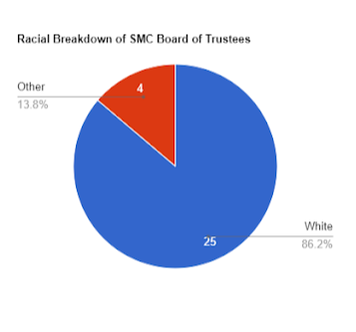
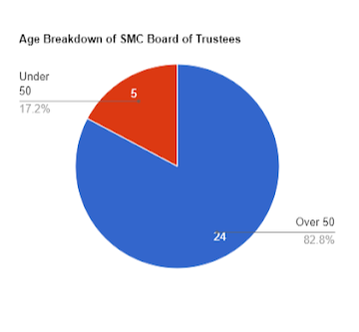
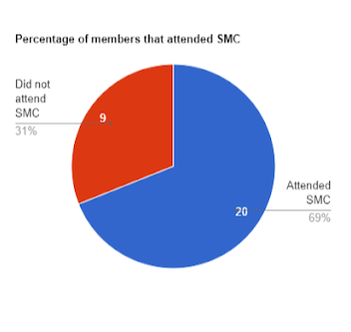
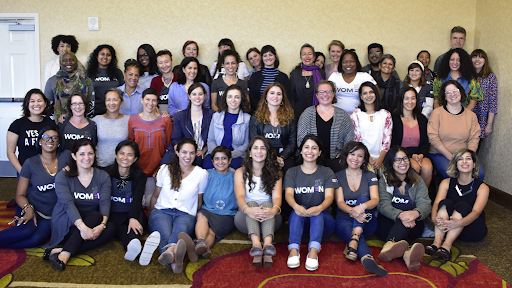
 RSS Feed
RSS Feed